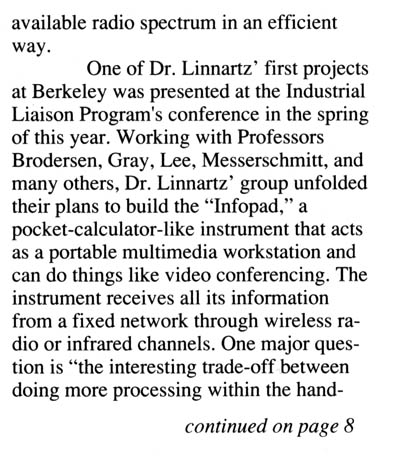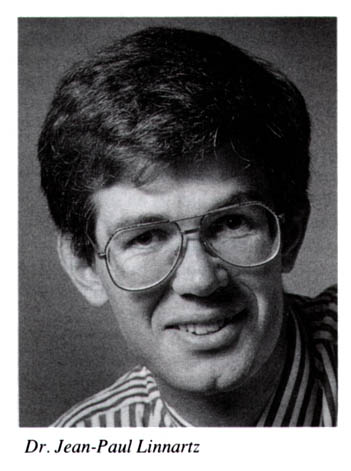|
|
|
||
 |
|||
 |
 |
 |
|
 |
|||
|
1992 |
New faculty member from The Netherlands
|
||||
|
The Department of Electrical Engineering and Computer Sciences welcomed a new faculty member, Jean-Paul Linnartz, in January 1992. His expertise includes the study of mobile communications. In addi-tion to his research, he taught "Signals and Systems" (EE 120) last spring and will teach "Random Processes in Systems" (EE 226) this fall. Professor Linnartz (whose name in Dutch is Johan Paul Marie Gerard Linnartz, but who uses Jean-Paul because his parents love France and its culture) came to Berkeley because of the university's reputation as one of the best. He said, "I want to remain a European, and I find the Bay Area a more European, international place than many other American cities." Dr. Linnartz received his master's degree in electrical engineering with dis-tinction from Eindhoven University of Technology in 1986; he received his Ph.D. degree in 1991 from Delft University, where he worked on multiuser land-mobile radio nets and also taught.As a high school student in The Netherlands, Dr. Linnartz studied classical Greek, Dutch, English, mathematics, physics, and chemistry. His many years of language studies, he said, helped him de-velop the analytical skills he uses today.
RESEARCH INTERESTS
Dr. Linnartz' research addresses mobile communications between transmitters in moving terminals and fixed-base stations, using the theory of random processes. His theoretical work involves the fundamental properties of communications systems. Linnartz studies how to organize many us-ers who interfere with each other. He is currently working on fundamental ways to address these many-user interference problems, and to develop new methods to study these problems. "The main problem," according to Dr. Linnartz, "is no longer how to de-sign a system against noise, but rather how to design a system in which competing ter-minals can work well sharing the radio spectrum." He doesn't want to build a new generation of telephone systems, he says, but wants to address the problem of many users and to find ways to share the available radio spectrum in an efficient way.
One of Dr. Linnartz' first projects at Berkeley was presented at the Industrial Liaison Program's conference in the spring of this year. Working with Professors Brodersen, Gray, Lee, Messerschmitt, and many others, Dr. Linnartz' group unfolded their plans to build the "Infopad," a pocket-calculator-like instrument that acts as a portable multimedia workstation and can do things like video conferencing. The instrument receives all its information from a fixed network through wireless ra-dio or infrared channels. One major question is "the interesting trade-off between doing more processing within the hand held terminal and using more radio spectrum for exchanging data." One of the most interesting new research problems for Dr. Linnartz is to combine the limitations imposed by the battery power consumption in hand-held phone sets with the need to accommodate as many users as possible on a system, and still have a high-performance system. Regulatory agencies (for example, the FCC) were traditionally only concerned with performance versus spectrum occu-pation, but power consumption is becoming a very relevant issue in defining new standards.
|
|||||
|
RAPIDLY CHANGING FIELD The radio communications field, accord-ing to Dr. Linnartz, is rapidly changing due to the complexity of systems. Dr. Linnartz has become very interested in communications policy. Regulatory prob-lems exist, and there is a need for electri-cal engineers to advise government. In The Netherlands, Dr. Linnartz was interested in the question of what a system should be used for. Although in most countries a large part of the spectrum is used for television broadcasting, it ap-8 pears more profitable to use it for cellular telephony instead. But the question re-mains whether such a market-driven allocation is desirable. This type of question led Dr. Linnartz to believe that it is no longer possible "to have politicians on one side, and electrical engineers on the other."
FUTURE PUBLICATIONS Dr. Linnartz will soon have a book on ra-dio communications published by Artech House in Norwood, Massachusetts. It is based on Linnartz' Ph.D. thesis and will be published in December 1992. The book will be entitled, Narrowband Land-Mobile Radio Networks, and will be of interest as a text for engineers interested in wireless personal communications systems. |
|||||
|
OTHER INTERESTS Dr. Linnartz enjoys taking photographs (he took a class at the ASUC studio on campus) and art in general (his father, Martin Linnartz, is an artist). Scientific re-search and art have a very close relation-ship according to Dr. Linnartz: "Trying to explain the world using a limited set of models is what both artists and researchers do."
|
|||||
|
|
|
||
 |
|||
 |
 |
 |
|
 |
|||